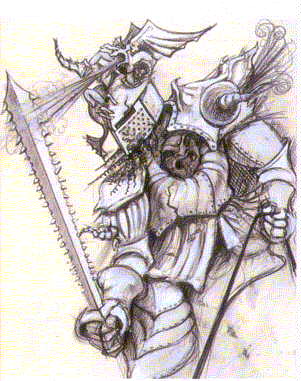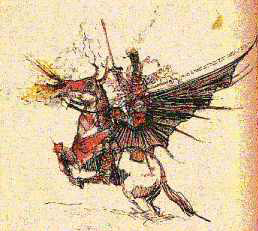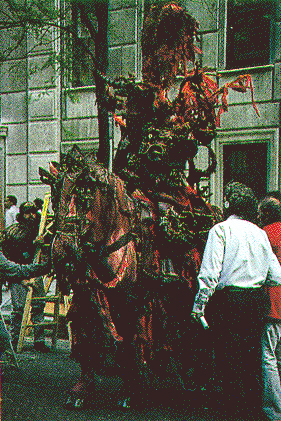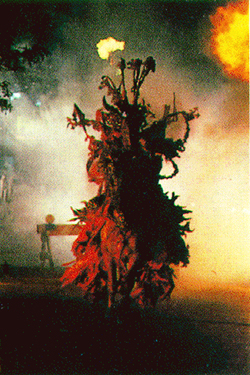THE TERRY GILLIAM FILES // "THE FISHER KING" (1991) |
A Red KnightmareTHE FISHER KING |  |
|
To a few New Yorkers who witnessed shooting of THE FISHER KING in the summer of 1990, the hellish, fire-breathing figure of the Red Knight — a phantom seen only by the disturbed street person played by Robin Williams — wasn't any great hallucination. "There was a guy who was pretty wigged out," recalled Williams. "He was going 'Yeah, I like that. I've seen that, too!'" Director Terry Gilliam, known for fantastical and demonic images in his previous films, had to create a figure that encapsulated all the fears of the stricken Parry, who comes to anguish at the mere thought of the Knight. Rather than rely on computer generated special effects, Gilliam and his team created a fire-and-smoke spewing suit of armour for the horse and rider's menacing gallups through New York City.
Gilliam's medieval bent, however, steered the conception in another direction. As Pasztor researched various ancient armour designs and etchings by Albrecht Durer, as well as the Claes Oldenburg book, "The Knife and the Warrior," the character of the Red Knight began to gel as a magnificent apparition — sinister, yet seductive. Pasztor enlisted Los Angeles artist Keith Greco, who in turn brought on Vincent Jefferds, a sculptor/designer. Inspired by the artwork of Hieronymus Bosch, Jefferds and Greco sought to create a heraldic figure right out of a medieval manuscript illumination.
Together Greco and Jefferds sculpted clay models from their sketches, from which full size mockups of the armour were created. Then they fashioned a suit out of latex over leather and urethane, with the flame-throwing helmet cast in aluminum and heavily fireproofed. Screen tests were conducted, at which point Gilliam asked that more, larger, uglier and darker elements be employed. The artists, collaborating with special effects consultant Bob McCarthy to realize the costume, adapted the design to ensure the safety of the horse and rider. The costume, which weighed approximately 125-150 pounds, was cushioned with lightweight materials to protect the rider in the event of a fall; likewise, ice packs could be inserted into the suit to keep stunt man Chris Howell cool. The costume was in fact entirely self-contained; Howell operated the battery-powered flame and smoke effects through buttons on his lance. Propane gas tanks for the helmet's bursts of fire were hidden in the saddle — as were the rider's oxygen bottles. [The breathing apparatus for Howell, to protect against smoke blown up into his face, also contained a two-way radio.] CO2, piped through the horse's head armour and spewed through a garden hose nozzle, looked like the horse's steamy breath.
Shot in silhouette, as much of the footage was, the Red Knight appeared like a Portuguese man-of-war, swimming in flame and smoke. Like the rest of the costume, however, the "wings" had to look as if they were on fire; with the aid of a torch, Greco reduced the 15 yards of silk to about five. "The 'Rot' has set in," he exclaimed. Over the course of several weeks, even into the shooting, the suit was modified both to enhance the design and to accommodate the dangerous special effects. One element tried was fiber optics within the helmet to simulate piercing, glowing eyes, but on film they appeared as pinpoints and were discarded. Sparks flying off of the horse's hooves and other optical enhancements were deemed unnecessary. Two horses, Lightning and Goliath, were used — one for galloping, one for rearing. At times they proved difficult to manage — getting one to rear atop a rock in Central Park did not pan out — but they were well-trained and grew accustomed to the most explosive special effects.
Most of the Red Knight footage was filmed in languorous slow motion; watching rushes for over an hour, one is awed by the beauty of its evil. The grotesque figures within the armour are reminiscent of the fantasy figures in BRAZIL, just as the flames recalled that film's Samurai Warrior's destruction. In THE FISHER KING's final cut, however, images of the Knight are used so sparingly, and so obscurely, that their effect is more visceral. Magnificent shots which Gilliam had captured, such as the horse galloping among the unseeing pedestrians on Fifth Avenue, were rejected. The director instead kept the audience outside of Parry's fractured point of view, to keep the Red Knight the wild vision of a demented man. The audience therefore comes away with an understanding of the debilitating power this hallucination has over Parry, without being drawn into and seduced by its grandeur. "I don't know if the Red Knight is going to be the weirdest thing in this film," Gilliam said during filming. "I'm beginning to think maybe the rest of it is as fantastical as the Red Knight."
From an article published in New York Newsday, October 1991.
For Related Articles on THE FISHER KING by David Morgan: "They're Getting A Gilliam Film" — On-set Production Story (Los Angeles Times "Calendar," June 24, 1990) Interview with Terry Gilliam — On Bringing a Myth to Life (Millimeter Magazine, March 1991) "Gilliam, Gotham & God" — The Filmmaker's Views of Urban Landscapes (Metropolis Magazine, September 1991) The original full-length interviews with Terry Gilliam and Robin Williams appear in "The Fisher King: The Book of the Film," published by Applause Books (now out of print but available via online sellers) | |||||||||||||||
copyright 1991, 2009 by David Morgan
All rights reserved.







 Costume Designer Beatrix Pasztor, whose wardrobe for Parry consisted of found objects that reflected the character's medieval point of view, initially wanted to create a fantasy out of found parts, like a Lower East Side sculpture garden. "It could have been made up from leftover metal pieces and car parts and all that industrial waste," she said. "It would have been a very New York, rough, mean Red Knight."
Costume Designer Beatrix Pasztor, whose wardrobe for Parry consisted of found objects that reflected the character's medieval point of view, initially wanted to create a fantasy out of found parts, like a Lower East Side sculpture garden. "It could have been made up from leftover metal pieces and car parts and all that industrial waste," she said. "It would have been a very New York, rough, mean Red Knight."
 Jefferds said, "The concept was of a knight as an incarnation of evil — disintegrating, burning away, rusting, with ash and embers, and the horse snorting like a locomotive." Fire was to burst out of the Knight's helmet, with smoke pouring forth from his joints, as if he were combusting inside. Even the massive Percheron circus horses, painted by animal colorist Douglas White, seemed to be stained by the dripping hot residue of the melting rider.
Jefferds said, "The concept was of a knight as an incarnation of evil — disintegrating, burning away, rusting, with ash and embers, and the horse snorting like a locomotive." Fire was to burst out of the Knight's helmet, with smoke pouring forth from his joints, as if he were combusting inside. Even the massive Percheron circus horses, painted by animal colorist Douglas White, seemed to be stained by the dripping hot residue of the melting rider.
 Delicate, brightly colored Chinese silk surrounding the Red Knight was attached to the rider's back and to the saddle with fishing poles and dune buggy antennae, so that the horse's movement — even the slightest breeze — would send the fabric swimming in the air.
Delicate, brightly colored Chinese silk surrounding the Red Knight was attached to the rider's back and to the saddle with fishing poles and dune buggy antennae, so that the horse's movement — even the slightest breeze — would send the fabric swimming in the air.
 In fact, they were more in danger from some New Yorkers, one of whom — disturbed by the late-night shooting on her block — tossed a bucket of water at the Red Knight from her apartment window. Fortunately, electrocution did not result.
In fact, they were more in danger from some New Yorkers, one of whom — disturbed by the late-night shooting on her block — tossed a bucket of water at the Red Knight from her apartment window. Fortunately, electrocution did not result.
